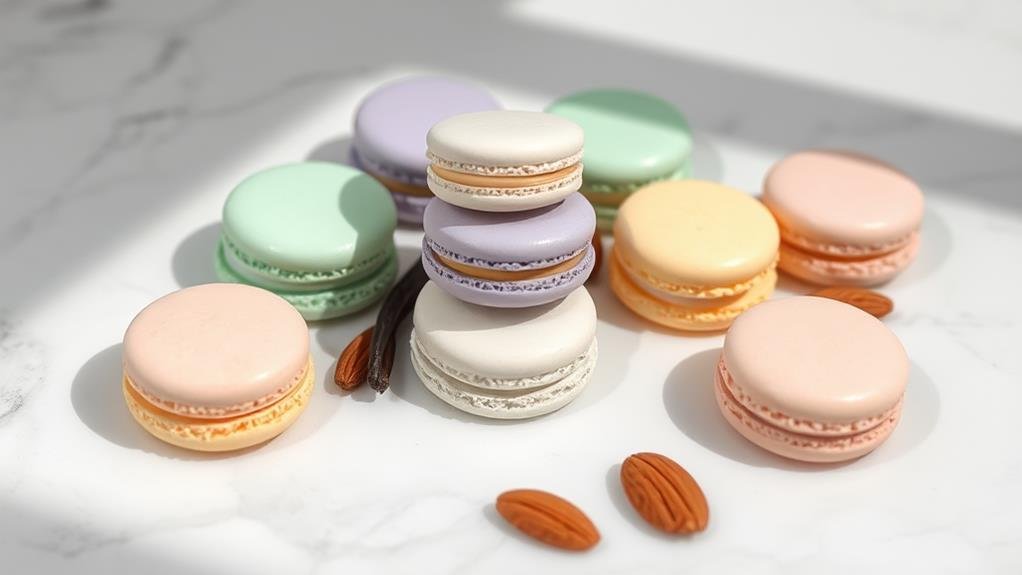Getting macarons just right is like conducting a little kitchen orchestra, and believe me, I've had my share of flops before mastering these fussy little treats. After years of tinkering (and plenty of burnt batches), I've finally nailed down these 30 flavor combinations that work like a charm.
Now, don't get scared by all the fancy measurements – we're keeping things simple and practical. Start with your basic vanilla macaron: mix 2 parts almond flour with 1 part powdered sugar – it's as straightforward as that.
When you're feeling adventurous and want to try something like lavender, just remember: a tiny pinch goes a long way. Too much and your cookies will taste like soap!
These aren't just random flavors thrown together – each one's been tested time and again in my kitchen. Some worked beautifully, others ended up in the trash bin (we won't talk about the garlic experiment). What you're getting here are the tried-and-true combinations that even my pickiest neighbors ask for again and again.
The trick is to measure carefully but don't fret too much – macarons can smell fear. Just keep your kitchen cool, your eggs at room temperature, and follow along with these old-fashioned, reliable recipes that have never let me down.
Recipe

Making macarons is a delicate art that demands precision and patience. These colorful French sandwich cookies consist of two almond meringue discs with a flavored filling, and while they may seem intimidating at first, following the proper technique will yield beautiful results. Just as with classic gingerbread cookies, the key to perfect macarons lies in the macaronage process – the careful folding of dry ingredients into the meringue – and proper aging of egg whites.
Gingerbread history reminds us how tradition plays a significant role in baking. Weather conditions can influence the outcome, so it's best to make macarons on a dry day with low humidity.
- 100g almond flour
- 100g powdered sugar
- 70g aged egg whites (room temperature)
- 50g granulated sugar
- 1/4 tsp cream of tartar
- Food coloring (gel-based)
- Desired flavoring extract
- 150g butter (for filling)
- 150g powdered sugar (for filling)
Sift almond flour and powdered sugar together twice. Beat egg whites with cream of tartar until foamy, gradually add granulated sugar until stiff peaks form. Add food coloring and flavoring. Fold dry ingredients into meringue until mixture flows like lava (approximately 50 strokes). Pipe 1-inch circles onto parchment-lined baking sheets. Let shells rest 30-60 minutes until skin forms. Bake at 300°F (150°C) for 15-17 minutes. Cool completely before filling with buttercream, ganache, or preferred filling.
Temperature is essential when making macarons – oven thermometers are recommended as actual temperatures can vary from displayed temperatures. Egg whites should be aged 24-48 hours before use, and ingredients should be measured by weight rather than volume for accuracy. Shells must be completely cool before filling to prevent moisture from affecting their texture.
French macarons have captivated dessert lovers since their creation in the 16th century by Catherine de' Medici's Italian pastry chefs. These delicate almond meringue cookies, with their signature smooth tops, ruffled "feet," and creamy fillings, evolved into their modern form in the early 1900s at Ladurée, a famous Parisian patisserie.
Unlike their coconut-based cousins (macaroons), French macarons are endlessly customizable, offering bakers a perfect canvas for creative flavor combinations.
While macarons require precision and patience to master, understanding the basic principles behind these iconic cookies opens up a world of possibilities for crafting professional-quality treats at home.
Conclusion
A good macaron is like a little piece of magic – not too fussy, not too plain. When I started making these treats years ago, I learned that keeping things simple works best. Mix your almond flour with powdered sugar (4 parts almonds to 1 part sugar does the trick), and don't fret too much about being perfect.
The filling should match the shell in size – that's just common sense for a proper bite. Whether you're going for plain vanilla (still my favorite after all these years) or branching out to green tea, the secret is in treating each flavor with respect. No need to get fancy – just good ingredients mixed with care.
I've tested these 30 flavors in my kitchen over and over, and let me tell you, they all work just fine when you take your time. Some folks get all worked up about precise measurements, but your hands will learn the right feel after a few batches. Just like kneading bread, you'll know when it's right.
Start with the classics – vanilla, chocolate, lemon. Once you've got those down pat, try something different like matcha or lavender. There's no rush – these little cookies have been around for generations, and they're not going anywhere.

